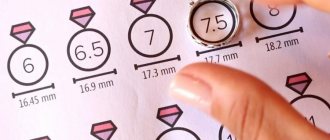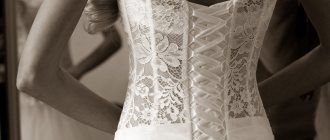A wedding celebration is a bright event that involves the presence of traditional attributes. One of them is the bride’s outfit, which attracts the attention of all guests. A luxurious wedding dress, exquisitely emphasizing the taste of the newlywed, will remind her of this day for a long time. However, throughout the entire banquet, a luxurious snow-white outfit can suffer greatly from various types of contamination, so advice on how to wash and steam a wedding dress at home will obviously not be superfluous.
Is it possible to wash a wedding dress at home?
A soiled wedding dress can upset a young wife with its appearance, but there is no need to despair. Wanting to solve the problem as quickly and without hassle, some women prefer to take their wedding dresses to dry cleaners, but the results of such companies are not always able to satisfy customers.
A stained wedding dress can be washed at home
Aggressive detergents and powders used to treat clothes in dry cleaning conditions can sometimes cause serious damage to the structure of a particular type of fabric. After such treatment, a luxurious wedding dress can become irreparably damaged, turning into a Cinderella outfit.

After dry cleaning, a wedding dress may lose its original appearance.
Wanting to avoid such a situation, it is advisable to wash the wedding dress yourself, using an individual approach to various types of contamination. This will help achieve maximum effect and will also guarantee the safety of your item. Provided the washing procedure is carried out correctly. On branded products you can easily find a label containing information about the type of fabric used in the manufacture of the outfit, as well as the manufacturer’s recommendations regarding washing and ironing of the product.
Initially, you need to inspect the dress for dirt, paying special attention to the hem, where traces of road dust most often remain, as well as the places under the arms where yellowish sweat stains form. Do not also forget about the inside of the bodice, which will also need to remove dirt. When preparing a wedding dress for washing, the type of material from which it is made is of particular importance. In most cases, in the manufacture of this kind of outfits, synthetic fabrics are used, which require hand washing.

A branded wedding dress must have a label with recommendations for its care.
Since various decorative elements in the form of beads, rhinestones and beads are used as decoration for wedding dresses, you should treat them very carefully during washing. In some cases, glue is used to fasten them, due to which the rhinestones can easily fly off. If this happens during washing, do not despair too much. It will be possible to restore floral patterns manually using threads or specialized adhesives.
Richly decorated bodice of a wedding dress
Tip: to accurately restore the decorative composition located on the wedding dress, take a photo of it before starting washing.
Features of washing dresses for a wedding
If you decide to put things in order yourself, you need to follow some rules:
- the outfit is soaked in warm water;
- When rinsing, use cold water and vinegar;
- Dry the dress away from direct sunlight.
It is highly recommended not to wash a silk dress at home. This fabric may shrink or become deformed when cleaning, so it is better to leave it to professionals.
The dress, made of 100% polyester , can be cleaned with washing powder. Both manual and automatic washing in the “delicate” mode are suitable for this purpose.

White satin and silk dresses should not be bleached using synthetic products, as the delicate fabric may turn yellow.
Colored outfits can be rinsed in water and vinegar to strengthen the color.
If the dress has a lot of decorative elements , before loading the product into the machine, it needs to be turned inside out. In this case, the water temperature should not be higher than 60°C.
What do signs say about washing clothes after the wedding?
There is a popular belief that a wedding dress should not be washed after the wedding, as this can lead to quarrels and disagreements in the family. However, according to a similar sign, well known to the residents of Bulgaria, a wedding dress can be safely washed a year after the birth of the first child.
There are a lot of signs and beliefs among people regarding wedding dresses.
According to another popular belief, a wedding dress must be washed no later than 40 days after the wedding day with the words: “What bad things you collected, you put away yourself. Amen” The meaning of such a ritual is to independently remove negative energy and the evil eye. Whether to wash your wedding dress for this reason is up to you to decide.
What materials are wedding dresses made from?
The bride chooses the material for sewing her wedding dress based on the time of year, body type and style. When selecting fabrics, it is important to take into account that it is of high quality, strong and at the same time beautiful.
Modern materials give free rein to the unbridled imagination of designers. Several types of fabrics can be combined in one dress.
The most popular materials used for sewing a wedding dress:
- atlas;
- brocade;
- taffeta;
- crepe;
- silk;
- organza;
- chiffon;
- tulle;
- lace;
- velvet;
- cotton.
The texture of the fabric can be matte, shiny, reflective, structured, airy or mixed. By type - natural and synthetic.
What detergents should you use?
When creating luxurious wedding dresses, various types of fabrics are used, such as silk, crepe de Chine, taffeta, nylon, organza, and tulle. All of them need delicate washing and require the use of gentle detergents, which should be chosen with great care. It is for this reason that wedding dresses are most often washed by hand, and the optimal means for them to ensure the desired result when washing are:
- saline solutions;
- soft washing powders;
- soap solutions prepared from laundry and baby soap.
Attention! When washing a wedding dress, it is not recommended to use bleach or detergents containing chlorine. The ingredients included in their composition can cause irreparable damage to the structure of tissues that require careful handling, forever ruining the appearance of the product. The result of treating a wedding dress with such means may be the appearance of unsightly stains and discoloration of colored fabrics.
Wash a handmade dress
Nowadays, classic models of wedding dresses are rarely found - most often the image of a bride is a corset and numerous shining rhinestones.
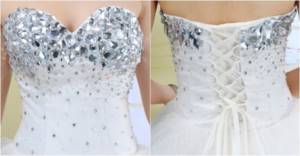
How to wash a corset with beads and rhinestones at home - the bandage dress can only be washed by hand or dry cleaned (starch, baby powder). For these purposes, a soap solution (foam) is used, which is applied to the corset exclusively with a soft sponge. Photo: svadbavo.ru
In exceptional cases and only if it is heavily soiled, you can soak the corset in soapy water and then rinse it. When soaking, the corset should remain horizontal and not touch the side walls of the container. Choose spacious and high basins for soaking.
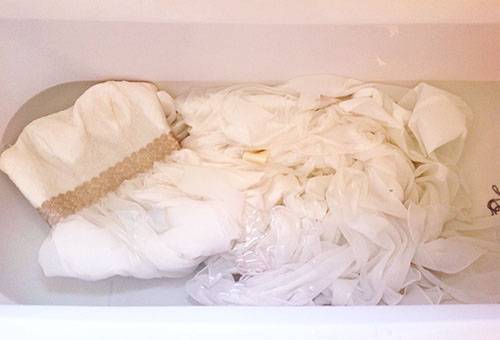
To avoid deformation, the corset should be in a horizontal position during washing and not touch the walls of the container. Photo: mschistota.ru
A dress with rhinestones can be washed using any of the above methods, but only by hand. After washing, check how tightly the rhinestones are holding - hem them if necessary.
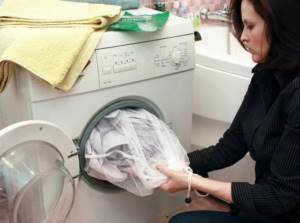
Machine wash only allowed for 100% polyester dresses, please read the label before loading
Getting rid of various contaminants
Wine stain
If a wine stain forms on your dress during a wedding, a hot soapy solution will help get rid of it.
- Lightly stretch the area of the wedding dress that has been so contaminated onto any utensil that is convenient for you. A small saucepan or bowl can play its role.
- Pour the soap solution directly onto the stain until it disappears completely.
- Wash the dress.
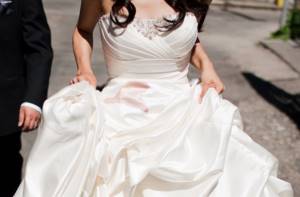
Wine stain on a wedding dress
How to remove sweat marks
If traces of sweat are found on the bodice of the wedding dress, you need to do the following:
- Wet the bodice area with soapy water.
- Treat the dirty areas with a sponge, without creating too much friction, so as not to spoil the texture of the fabric.
- If sweat stains remain on the silk material, you can clean it with a saline solution.
- To prepare it, take 250 ml of water and 1 tablespoon of salt.
- Apply the solution to the cloth and rub it gently.
- Rinse off the solution with clean warm water.
What to do with other types of stains
Stains of other types can be removed using a soap solution prepared with laundry soap.
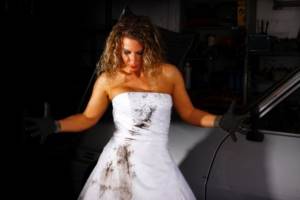
Any stains can appear on a wedding dress
- Spray a damp cloth with soapy water.
- Rub it gently with a brush.
- Rinse off the solution with warm water.
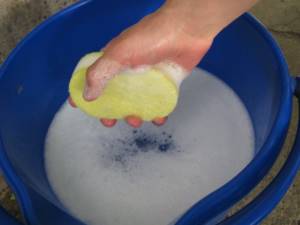
Using a soap solution can remove some dirt from a wedding dress
Baby powder is also suitable for removing stains from a wedding dress.
- Apply the powder directly to the stain and leave for 3 hours.
- After the specified period, you must carefully clean the powder from the fabric.
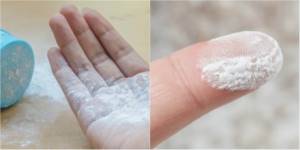
Baby powder can be used to remove stains from a variety of materials.
Starch has similar properties, using which you can get rid of greasy stains within ten minutes.
- Rub the starch into the stain with light movements and leave it in this state for 10 minutes.
- Then remove any remaining starch.
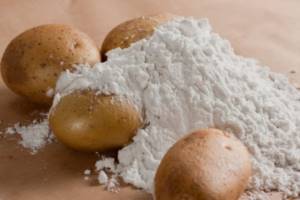
You can deal with stains on a wedding dress using starch
If during a photo shoot traces of grass have formed on your wedding dress, ammonia will help correct the situation:
- Treat contaminated areas of fabric with a cotton swab soaked in ammonia.
- Then wash these areas with laundry soap.
- Wash your wedding dress.

Grass can leave stains on a wedding dress
Sometimes the stains can be too complex and not amenable to soap solutions. In this case, it is advisable to use industrial stain removers. For this purpose, Oxy Clean stain remover is quite suitable, ideal for fabrics that require careful handling.
- After carefully reading the instructions, create a solution using this product and immerse the heavily soiled part of the outfit in it.
- Wait until the stain disappears completely.
- Wash the dress.
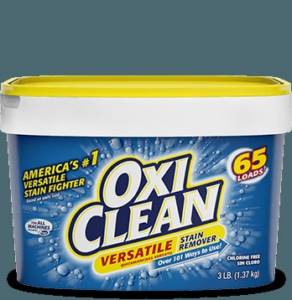
Using Oxy Clean stain remover you can get rid of difficult stains
Five ways to clean stains from your wedding dress
- To remove sweat stains, wipe the stained areas with a cotton pad and a strong solution of salt and water;
- Treat wine stains with a soft sponge and hot soapy water;
- Grass stains are removed with ammonia. To do this, pour a spoonful of alcohol into a glass of warm water and mix the ingredients. Soak a cotton pad in the mixture and wipe away any dirt. When they dry, wash the stains with laundry soap and then rinse with clean, cool water;
- Warmed glycerin will remove cake stains. Soak a cotton pad in the mixture and wipe the contaminated areas. After 15 minutes, rinse the treated area with clean warm water;
- To clean stains from silk, mix 10% ammonia, glycerin and water. Wipe the areas with a cotton pad containing the solution and rinse with warm water.
How to clean a hem
If you need to clean the hem of your wedding dress, use the following recommendations.
- Create a strong soap solution using warm water, or dilute detergent in water.
- Immerse the hem of the dress in water and leave it in this state for several hours. Then, using a toothbrush, begin to gently clean the edge.
- After completing the procedure, wash the dress.
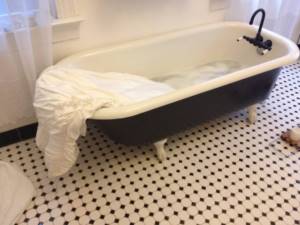
The hem of a wedding dress can be washed in a saturated soap solution
Bleaching things
Delicate fabrics should be treated as such. Before sending an item for storage, you need to bleach your outfit so that after a few years it does not show yellow stains from sweat or other contaminants.
Whitening methods:
- Soak the wedding dress in Vanish. First treat visible stains, then place the dress in water at 30°C, add Vanish and whip up the foam. Leave until morning. If the water turns yellow earlier, drain the waste water and add clean liquid.
- Use Oxi Clean. Apply the product to armpits and other spots. Leave for 2 hours for best effect. Wash the dress completely at 30°C.
- Hydrogen peroxide is an excellent whitener. The product is completely soaked in the solution or stains are removed locally. For soaking, dilute peroxide with water at the rate of 1 glass per 15 liters of water. To remove stains locally, moisten a cotton swab with the product, treat the stain, and rinse with clean water after 5 minutes.
To whiten a wedding dress, use sparkling water, a soapy solution from laundry soap, hairspray for ink, and baby powder for lipstick stains.
How to wash a wedding dress by hand
If you want to wash an outfit by hand, you should take into account some nuances, following a certain algorithm:
- Fill the bath with water, the temperature of which will not exceed 30 C, by a third.
- Add laundry detergent and thoroughly dissolve it in water.
- Place the outfit in water with the product and let the fabric get wet. This may take approximately 20 minutes.
- Then take a sponge and, having soaked it in the same soap solution, begin to clean the hem and corset of the dress, without resorting to strong rubbing.
- Then, after removing stains and other contaminants from the dress, leave the dress in the same water for another 2 hours.
- After the specified time has passed, rinse the product in clean water using a shower. This will more effectively rid the fabric of detergent residue.
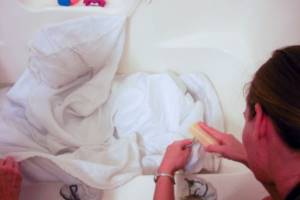
Hand washing can restore your wedding dress to its original appearance.
Attention! Do not add the product to water that the dress is already in. With this approach, the product may not dissolve completely and the washing result will be minimal.
There is another way to wash a wedding dress by hand.
- Take a hanger and put your wedding outfit on it.
- Hang a dress hanger above the bathtub.
- Wet the dress with water using the shower.
- Prepare a soap solution and, after dipping a sponge into it, gently wipe the damp fabric of the dress with it.
- Then raise the shower to its maximum height and begin to slowly rinse off the soapy solution from top to bottom.
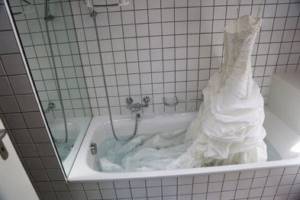
The wedding dress can be washed by hand effectively
When performing all these manipulations, try not to stretch the fabric too much to avoid deformation.
Attention! If the wedding dress is decorated with embroidery, it is recommended to cover it with thick fabric, and only then begin the washing procedure. If you have small and metal decor, it is advisable to treat it with glycerin. This will protect shiny elements from tarnishing and mechanical damage.
Outfit storage
There are some features:
- In order for your dress to last for many years, you need to create good storage conditions for it.
- If you send your dress to the dry cleaner, they will return it to you in a special case. But you cannot store your outfit in a case; it can only be used to transport your outfit.
- It is best to store a wedding dress in a box, but not a simple one, but one made from archival paper. Because it does not decompose and does not release any acids.
- Store the dress horizontally. This will help prevent wrinkles from forming.
Every girl who has not entrusted her main wedding decoration to a dry cleaner should know exactly how to clean her wedding dress. With the right approach to the process of cleaning a holiday outfit, it will look like new immediately after ironing - then the hero of the occasion can calmly hang it in the closet, and then proudly show it to her daughter, or look at the dress in private, remembering the wonderful day of unity with her other half.
Anastasia Belozerova
Wedding planner
Previous article
Golden mid-autumn. Wedding in October 2021: favorable days of the year, features and signs
Next article
Washing in the machine
According to information provided by manufacturers, some wedding dresses can be machine washed. However, even with this option, dirt and stains should be removed in advance, taking into account their individual characteristics.

The wedding dress can be washed in the washing machine
By washing a wedding dress in an automatic machine, you can achieve the desired result, provided you follow some basic rules:
- When washing in a washing machine, the machine must be set to the delicate mode in the shortest possible cycle. It should be noted that washing such products is permissible only at a temperature of 30 C;
- When washing such dresses, it is not recommended to use ordinary washing powders. As a replacement, specialized cleaning solutions intended for items made of delicate fabrics, as well as lace, or liquid colorless products can be used;
- if there are various metal decorative elements on the outfit, you need to take care of their protection by using glycerin before washing;
- for more effective protection, it is also recommended to cover the areas of the product equipped with embroidery and beaded with thick fabric or gauze;
- When washing a wedding dress in a washing machine, it is recommended to use a washing bag that can protect the item from damage;
- When washing a dress made of tulle and characterized by pomp, you can add a little starch to the washing machine. With its help it will be possible to preserve the structure of the fabric.
Attention! When washing a wedding dress in a machine, you cannot use modes with a high number of revolutions, as well as automatic spinning. This can lead to deformation of the corset and ruin the delicate fabric.
Rules for washing a wedding dress in a washing machine
If the wedding dress is allowed to be washed automatically, then a number of rules and precautions still need to be followed:
- if the bodice is decorated with protruding elements, then you need to baste the fabric on top;
- metal parts of the corset can be lubricated with glycerin to protect them from darkening;
- you need to use a special washing bag;
- add liquid SMS;
- Wash at a temperature no higher than 30 degrees, on a delicate cycle without spinning.
Tip: if you add starch when washing tulle skirts, the properties of the fabric will be preserved.
How to dry an outfit
An equally important and responsible procedure is drying and ironing a wedding dress. Under no circumstances should you wring out the dress after washing. Delicate fabric may lose its original appearance, causing the dress to be damaged.

Wedding dress drying outdoors
There are several ways to dry a dress. One of them involves performing this procedure using a hanger. It is believed that the weight of a wet dress will ensure that the folds straighten spontaneously. However, it is worth considering that a heavy, wet wedding dress hanging in this position may become deformed during the drying process.
A safer method is considered to be the method in which such an outfit is laid out on a plane.
- To allow most of the water to drain from the wedding dress, place a grate on the bottom of the bathtub, and lay the dress itself on top of it.
- Then, after some time, making sure that the water has drained as much as possible, hang the dress on a hanger, not forgetting to smooth out the fabric layers.
- After 2 hours, you can hang the wedding dress on the balcony, however, you must make sure that the dress is located in the shade. This will save it from yellowing.
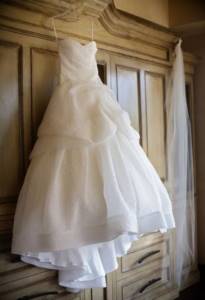
The wedding dress can be dried on a hanger by hanging it on the balcony
It is also not recommended to judge a wedding dress next to heating appliances and radiators.
Drying Tips
- It is contraindicated to wring out a washed wedding dress, either manually or automatically.
- It is recommended to place the outfit in the bath to get rid of excess water.
- Once the excess liquid has drained, you should move the wedding dress to a place with good air circulation.
- During the process of drying the product, you need to ensure that all folds are carefully straightened, then you will be able to prevent the appearance of creases.
- Protect the outfit from sunlight and do not place it near heating devices; the material of the wedding dress can turn yellow and become more rigid.
Important! Wedding dresses made of cotton, satin, or polyester materials should not be dried in a canopy; they may stretch out. They are recommended to dry horizontally on a thick cloth or towel.
How to iron a wedding dress
After the dress is dry, you can start ironing it.
- Particular attention should be paid to the surface on which the dress will be placed. It must be spotlessly clean. To prevent the appearance of new stains, it is advisable to cover the ironing board with a white and clean sheet. At the same time, the iron you are going to use must also be spotlessly clean.
- If the dress is made of satin material, ironing must be done by turning the product inside out. Otherwise, the front side will forever lose its original shine.
- If the wedding dress has lace inserts, when ironing it it is necessary to use additional layers of fabric placed between the product and the iron. Muslin or cotton can be used as such material. Before starting the ironing process, set the iron to silk mode and use the additional steam function.
- Products made from tulle and chiffon require steaming only, without ironing. This procedure is traditionally performed under a canopy, initially treating the lining.
- However, you should know that the lining of a wedding dress, which is a soft mesh, will not become perfectly smooth. However, in this case it is considered absolutely normal.

The wedding dress can be ironed with an iron or steamer
Ironing a wedding dress
After the wedding dress has completely dried, it may need to be ironed, but this should be done carefully and with caution:
- make sure that the soleplate of the iron is absolutely clean, without soot, scratches or rust;
- check the ironing surface to ensure that it is free of stains from elements that could catch the fabric;
- set the temperature no higher than 100 degrees;
- start ironing the product from the wrong side;
- Silk, satin and lace fabrics should be ironed through gauze.
Note: a mesh petticoat will inevitably bend slightly after washing, but will not lose its functions.
How to steam properly
Sometimes, wanting to put a dress in order after washing, it is necessary to carry out the steaming procedure. With its help, you can smooth out fabric layers, as well as give the original appearance to frills, ruffles and bows. You can cope with this task using various methods:
- holding the dress over the steam;
- ironing a wedding dress;
- using professional steamers.
Using boiling water
To create the required amount of steam at home, you will need a pan of boiling water.
- Pour water into a large saucepan and place it on the fire.
- As soon as the water boils and steam begins to appear, one person should hold the dress in a canopy, directly above the boiling pan, and the second, meanwhile, monitor the direction of the steam, exposing problematic areas of the outfit under it.
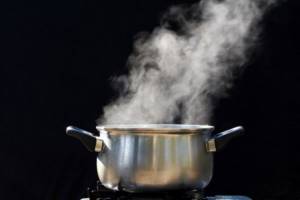
Steam from boiling water will help smooth your wedding dress
The second method is as follows:
- Place the dress on a hanger and hang it over the bathtub.
- Pour boiling water into the bath, making sure that the hem of the wedding dress is above the hot water at a height of at least 20–25 cm.
Under the influence of humid air, the material will begin to straighten out, but this may damage the decor glued to the dress.
Using an iron
- When using an iron to steam your wedding dress, make sure you have gauze or special fabric designed for ironing delicate fabrics. It is quite possible that in order to successfully complete all the actions you will need an assistant who will support the wedding outfit.
- Line your ironing board with a clean sheet.
- Set the temperature to unity.
- Turn on the steam and set it to gentle.
- Fold the gauze into 2-3 layers and spread it over the wedding dress.
- Lightly go over it with an iron. If these steps do not provide the desired result, increase the temperature to two degrees.

Using an iron you can effectively steam a wedding dress
Attention! If the wedding dress is made of satin, the ironing temperature should be two degrees and in this case the steam function can be used. If the dress has organza inserts, it is best to iron such material at a temperature of one, without steam.
- For high-quality ironing of sleeves, it is advisable to use a special stand, which is included in the standard equipment of the ironing board.
- When ironing and steaming a skirt, you should start the procedure from the lower layers, gradually moving to the upper ones.
- When working with a bodice equipped with decorative elements, place a terry towel on the ironing board.
Tip: to prevent the sleeves from becoming deformed or wrinkled after ironing, twist the white sheets into a tube and place the tube in the middle of the sleeve.
How to treat a wedding dress with a professional steamer
If you have a steamer at your disposal, the procedure for smoothing out wrinkles and wrinkles that have formed on a wedding dress will be resolved as quickly as possible. Thanks to the operation of the steam generator, it will be possible to steam a wedding dress without touching it with the device itself.
- Before starting work, pour the required amount of water into the device, according to the manufacturer’s recommendations, and then turn it on.
- Hang the product on a hanger and begin the steaming procedure, treating the skirt and flounces first, and then move on to the sleeves and bodice.
- After completing the work, let the dress hang for several hours, and only then send the outfit to the closet.
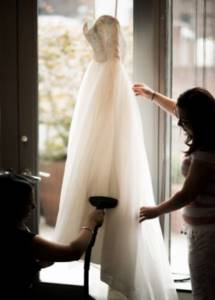
A steamer will most quickly and effectively help restore a wedding dress to its original appearance.
Nuances for different fabrics
Satin dress
If your dress is made of satin material, it is better to iron it from the wrong side without using water, which leaves unsightly streaks on such fabric. After ironing a certain part of the dress, let it cool completely and only then proceed to the next part of the outfit.
Atlas requires special treatment
Lace dress
A lace dress should be steamed using the lowest temperature possible. Otherwise, delicate lace may acquire a yellowish tint. When ironing such an outfit with an iron, be sure to use thick gauze to protect the main material of the item from scorching. When working with cuffs and collars, it is advisable to use liquid starch, which can be applied using a spray bottle. This will provide the lace elements with a flawless appearance.

The lace may turn yellow during steaming.
Dress with decor
If the wedding dress is richly decorated with beads, sequins, beads and other decorative elements, it is practically impossible to do without a steamer, and you should keep it at a good distance so as not to damage the elegant decor.
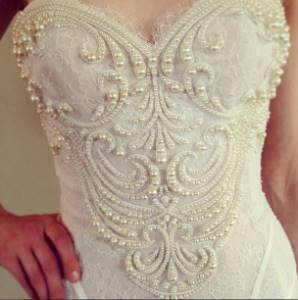
When ironing and steaming a wedding dress, you should pay close attention to the decor.
If you don’t have a professional steamer, you can order a similar service from private laundries that offer home visits. Thanks to the work of professionals, your wedding dress will be able to regain its original appearance without much hassle on your part.
How to iron a veil
One of the traditional elements of a wedding dress is a veil, which also requires some care, including ironing. If the wrinkles are too severe, you can use a professional steamer when ironing the veil.
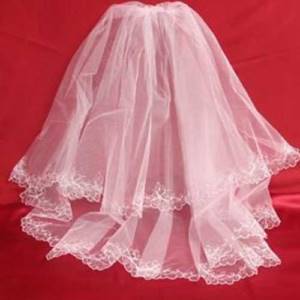
You can return the veil to its original appearance using ironing and steaming procedures.
Using a steamer
Hang the veil on a hanger and run the steamer over its entire length, starting from top to bottom. You can also use an iron held at a short distance from the material. This method is effective when working with tulle, and is the safest.
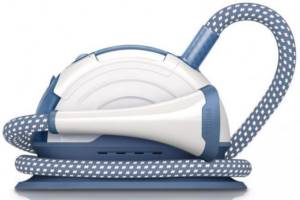
A steamer will allow you to gently smooth the veil
Using hot water
You can also steam the veil using hot water. This method is similar to the method of steaming the wedding dress itself. Pour boiling water into the bath, after hanging a veil over it, and hold it over the steam for 20 minutes.
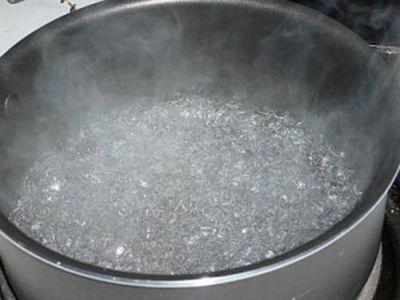
The steam rising from the surface of the boiling water will smooth the veil
Using a hair dryer
An ordinary hair dryer will help you quickly get rid of bruises:
- Set the appliance to medium drying temperature.
- Using a spray bottle filled with water, treat uneven surfaces of the product.
- Dry the wet material with a hairdryer.

You can use a hairdryer to smooth out wrinkled veils.
Using a directed steam jet
If there are a small number of folds on the veil, you can use a directed stream of steam coming from a kettle with boiling water. Bring a crumpled section of material to a steam source, and it will instantly smooth out under the influence of moist air.

A targeted jet of steam will ensure effective smoothing of wrinkled veils
Iron
In some cases, ironing may be necessary, however, some recommendations should be followed.
- The veil must be laid out on a clean ironing board.
- The iron must be set to the minimum temperature, or “synthetic” mode.
- On top of the veil you should place an ironing cloth or gauze folded in 3 layers.
- When ironing the product, you must ensure that the base material does not come into contact with the hot sole of the device.
- If the veil is decorated with artificial flowers, sequins or beads, these areas must be covered with a terry towel.
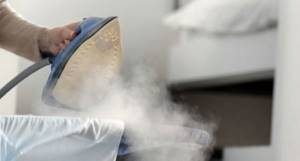
The veil can be gently ironed
In some cases, you can smooth out a veil by first soaking it in water with a softener and drying it in a suspended and straightened state.
Handwash
When starting to hand wash such a complex item as a wedding dress, you need to follow a clear sequence of actions.
Proper preparation is an essential part of cleaning a wedding dress.
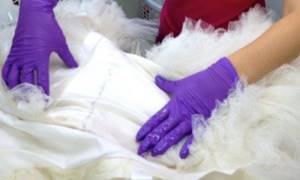
You need to start by inspecting the thing. Torn and damaged areas need to be repaired before washing. If they are not addressed in time, the defect can only become more noticeable and larger in area.- If there are stains on clothing, they should be treated first. To do this, it is advisable to know what they are left with.
- All elements that can be detached from the dress must be removed.
Depending on the composition of the material, household chemicals or homemade recipes can be used for stains.
Even subtle stains should be wiped with a mild soapy solution and a sponge . If you leave them, the spots will appear brighter over time. Folk recipes and store-bought stain removers will come to the rescue.
For dresses that have a slight tint of yellow, beige, pink or other tones, you need to use household chemicals designed for colored clothes.
To wash a wedding dress, you must use non-hot water at a temperature of +30ºС to +35ºС . Hotter temperatures can cause fabric deformation and shrinkage of the material.
Detergents should be chosen that are delicate. Preferably in gel form. It is better not to use washing powders due to their rough texture and poor dissolution in water compared to liquids.
Procedure:

Fill a large container with water at the required temperature.- Dilute the detergent.
- Dip the dress into the soap solution.
- If there are dirty places, such as the hem, you can gently soap them with a soft sponge.
Soaking should not be long - up to a quarter of an hour, maximum - up to 20 minutes. - Acting carefully, the item is erased. Do not rub the fabric.
- The rinsing must be very thorough so that no detergent residue remains in the fibers of the material.
To do this, the water should be changed several times. The final rinse can be done by hanging the product over the bathtub and directing water from the shower onto it. - A wet dress should not be twisted. It is hung to allow water to drain from the product.
If the outfit does not require a full-scale wash, you can hang it over the bathtub, moisten it with a shower head, and wash only the necessary areas.






